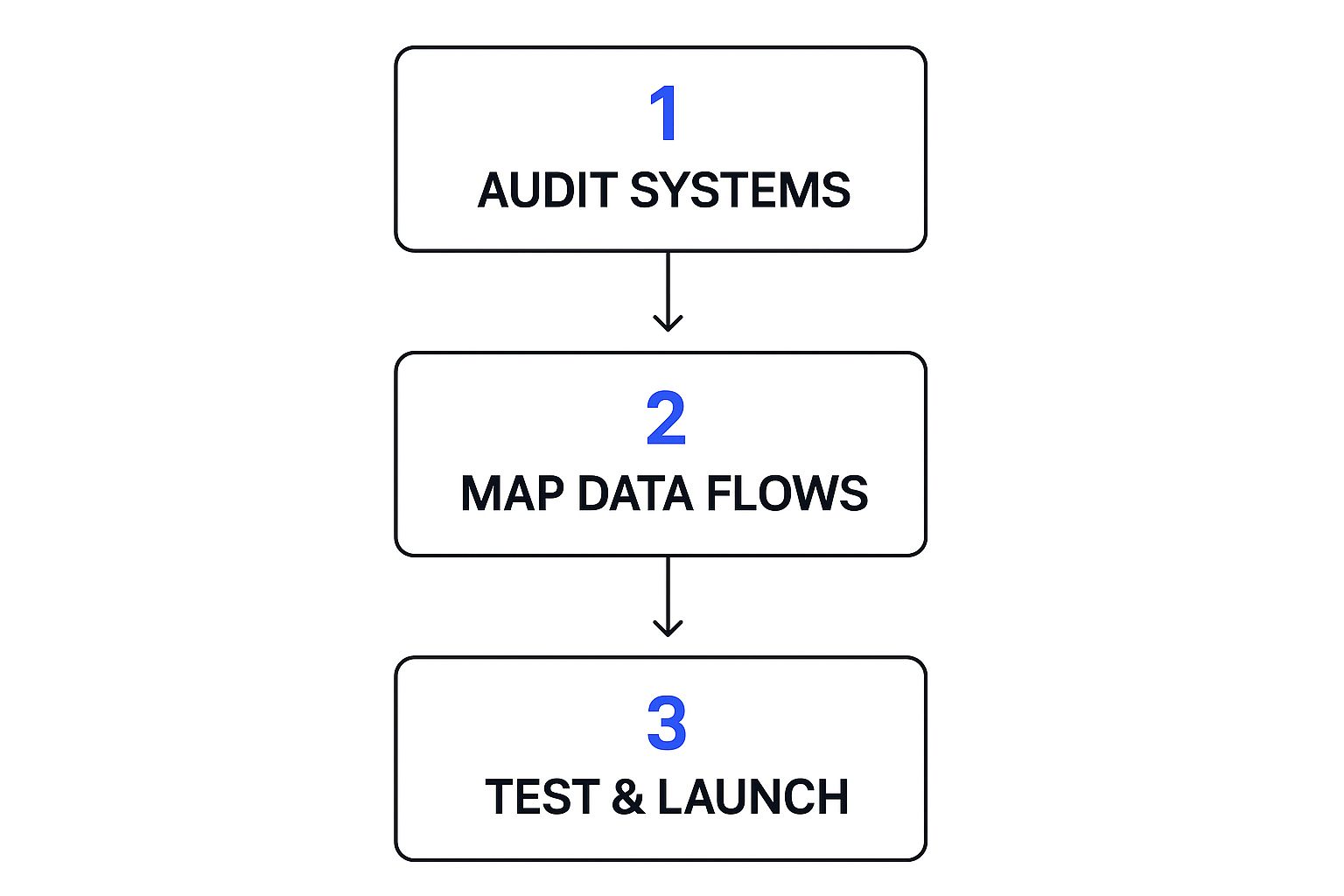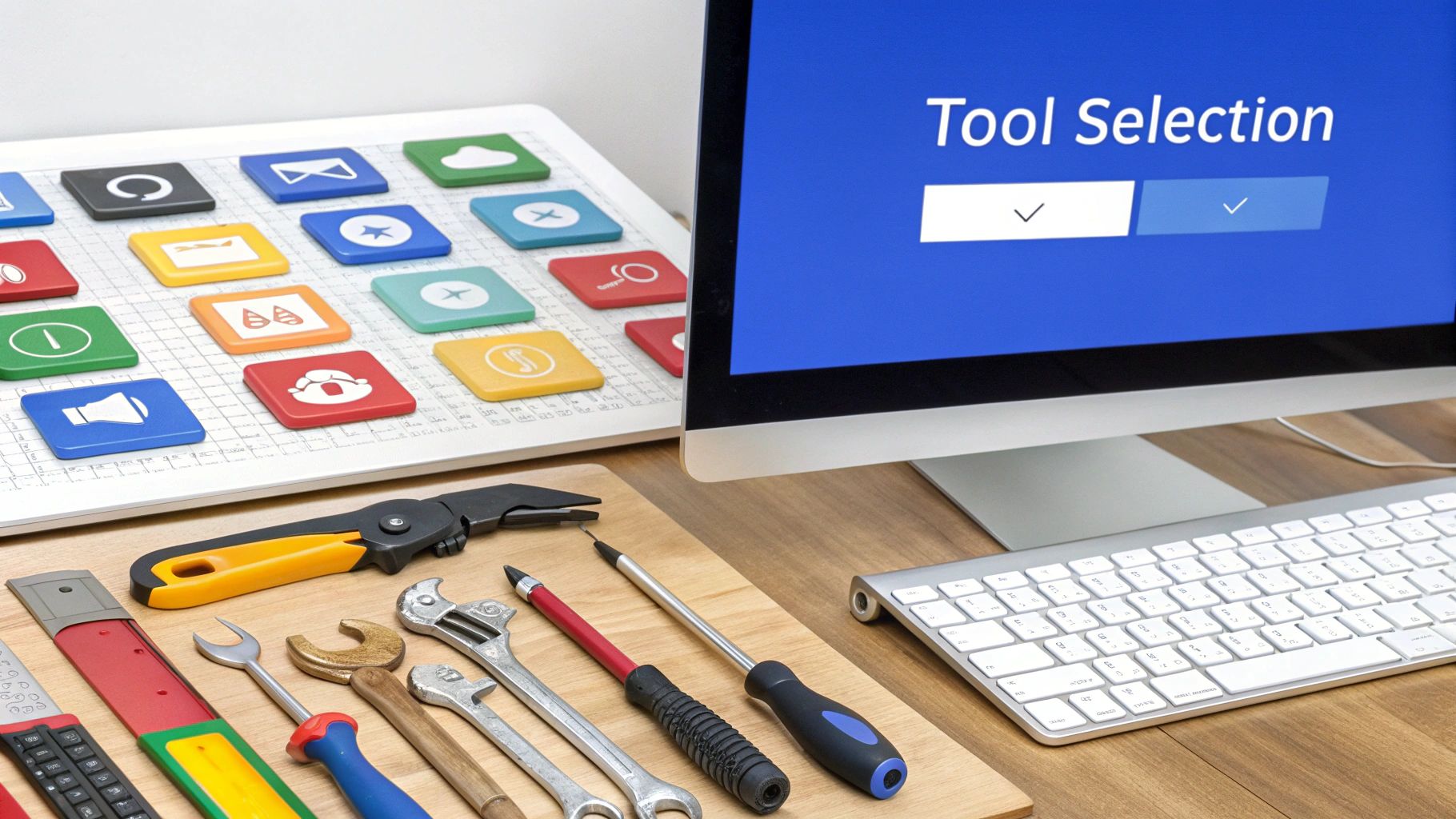
Discover how marketing automation integration can streamline your data, improve workflows, and boost ROI. Learn more today!
Marketing automation integration isn't just a technical task; it's about making your separate software tools—like VideoQi and your CRM—talk to each other. When they share data, they stop being individual instruments and start playing together like a well-rehearsed orchestra.
This connection creates a single, powerful system. It’s what lets you automate entire workflows, deliver truly personalized experiences, and finally ditch the mind-numbing task of manual data entry. You’re essentially upgrading from a collection of disjointed tools to a smart, cohesive marketing engine.
Why Smart Integration Is No Longer Optional
In today's marketing world, disconnected tools are more than just an inconvenience—they’re a direct hit to your revenue. When your video platform, CRM, and email service operate in their own little worlds, you get data silos. These information gaps create a choppy, fragmented view of your customer’s journey and lead to countless missed opportunities.
A smart marketing automation integration is the bridge over those gaps. It takes all those isolated data points and turns them into intelligence you can actually use.
Imagine this scenario: a hot prospect watches 90% of your new product demo on VideoQi. Without integration, that powerful buying signal is stuck. It's just a number in your VideoQi analytics. Your sales team has no idea it happened, and your marketing platform can't trigger an immediate follow-up. The lead, once warm, starts to go cold.
Now, picture it with integration. That same viewing behavior instantly updates the lead's score in HubSpot, assigns a task to a sales rep, and enrolls the prospect in a highly targeted nurture campaign. This is the moment integration stops being a "nice-to-have" and becomes a core part of your strategy.
Core Integration Benefits and Key Platforms
Before we dive into the "how," it's helpful to see the bigger picture. Connecting your platforms unlocks specific advantages that directly impact your bottom line. This table breaks down the core benefits and highlights the major players we'll be discussing.
| Benefit Category | Key Advantage | Featured Platform Example |
|---|---|---|
| Unified Customer View | Consolidates all customer interactions into a single, comprehensive profile. | HubSpot |
| Workflow Automation | Triggers actions (emails, tasks) based on customer behavior, saving time. | Marketo |
| Lead Scoring & Prioritization | Automatically identifies and flags sales-ready leads for immediate follow-up. | Pardot (Salesforce) |
| Deep Personalization | Uses real-time data to tailor content, messaging, and offers at scale. | ActiveCampaign |
Ultimately, a well-integrated system gives you the agility and insight needed to outperform competitors who are still manually piecing their data together.
Turning Data Into Revenue
The real magic of connecting VideoQi to your marketing hub is its ability to transform passive data into active, revenue-generating workflows. This isn't just about saving a few hours a week; it's about unlocking a much deeper understanding of your customers.
This seamless flow of information allows for the kind of hyper-personalization that actually converts. To see this in action, you can explore detailed strategies for Shopify marketing automation that perfectly illustrate how connected systems drive e-commerce growth.
The goal is to create a responsive marketing ecosystem. When one tool registers a customer action, the entire system should react in a coordinated, intelligent way to guide that customer toward conversion.
This move toward interconnected systems is a major industry trend. The global marketing automation market was valued at $5.7 billion and is on a steep growth trajectory, fueled by the demand for more sophisticated, data-driven marketing. You can learn more about the marketing automation market's rapid growth to understand the forces behind this expansion.
The takeaway is simple: businesses that integrate their tools are far better positioned to win.
Build a Blueprint for Seamless Integration
A successful marketing automation integration doesn’t start with code or APIs. It starts with a plan. I’ve seen too many teams jump straight into the technical setup, eager to connect their new tools, only to end up with a messy, ineffective system. It’s like starting a road trip without a map—you’ll definitely go somewhere, but probably not where you intended.
This upfront planning is where you turn a vague idea like "connect our tools" into a concrete strategy. The first thing to do is take a hard look at your current marketing tech stack. Be honest. Where are the real friction points? Are your sales and marketing teams looking at completely different sets of data? How much time is wasted manually exporting a list from one platform just to import it into another? These are the problems you're trying to solve.
Define Your Integration Goals
Once you've identified the pain points, you can set sharp, measurable goals. Vague objectives just don't cut it. "Improve marketing" is a wish, not a goal. You need something specific to aim for.
For instance, a great goal sounds like this: "Decrease lead response time by 50% by automatically creating a sales task in our CRM the moment a prospect watches over 75% of a VideoQi product demo." Now that’s a target. It’s specific, measurable, and gives everyone a clear benchmark for success.
To really nail this, you need to get comfortable with the fundamentals of how data moves between systems. If you're looking to build a solid foundation, it's worth your time mastering the data integration process.
Map Critical Data Flows
With clear goals in hand, you can start mapping out the actual data you need to move. This is the most critical part. It’s not about syncing every single piece of data you have; it’s about syncing the right data to achieve your goals.
Think about the specific actions that matter. Here are a few real-world examples I see all the time:
- Video View Duration: Syncing how long a known contact watches a VideoQi video directly to their activity timeline in HubSpot.
- CTA Clicks: Recording a click on an in-video call-to-action as a specific, triggerable event in Marketo.
- Form Submissions: Passing lead information from a form embedded in a VideoQi video straight into a new contact record in Pardot.
Mapping this out visually can be a huge help. This screenshot shows a clear interface for mapping data fields between two different apps, which is exactly what you'll be doing.

This kind of visual mapping is essential. It ensures the "First Name" field from one system populates the "First Name" field in the other, preventing a lot of headaches and costly errors down the line.
Finally, give someone ownership. Every project I've seen succeed had a clear champion—a person responsible for pushing the project forward, getting the right people in the room, and holding everyone accountable.
Key Takeaway: A detailed integration blueprint becomes your project's single source of truth. It gets marketing, sales, and IT all on the same page, working toward the same objective. This simple document dramatically increases your chances of getting the integration right the first time.
Connect VideoQi with Your Marketing Hub
Alright, you’ve got your strategy mapped out. Now for the fun part: making it all work. This is where we plug VideoQi directly into the heart of your marketing operations, transforming your plan into a living, breathing system. Getting this marketing automation integration right from the start is all about being methodical to ensure a clean, stable connection.
While every platform has its own quirks, you'll find that connecting VideoQi to major players like HubSpot, Marketo, and Pardot follows a pretty similar script. It’s less about wrestling with complex code and more about a careful, step-by-step setup. You'll usually authenticate with an API key and then configure how the data should flow.
The infographic below breaks down the typical journey for a successful integration, from the initial audit to launch day.

Notice how much of the work happens before you even connect the systems. Auditing your setup and mapping your data fields first is the secret to a smooth launch.
Connecting VideoQi and HubSpot
For the thousands of businesses that live and breathe HubSpot, you’re in luck. Integrating VideoQi is refreshingly simple. The entire HubSpot ecosystem is designed for these kinds of connections, making it a breeze to get video engagement data flowing right onto your contact timelines.
First, you'll head over to your HubSpot account's integration settings and find the option to connect a new app. Search for VideoQi in the App Marketplace and follow the prompts. This part is pretty standard—you'll grant VideoQi permission to access specific data, like your contact records and timelines.
Once you're authenticated, the real magic happens on the configuration screen. This is where you tell HubSpot what to do with the data from VideoQi. For example, you can set up rules like:
- Video View: Create a new timeline event in HubSpot the moment a known contact starts watching a video.
- View Percentage: Update a custom contact property (say,
video_view_progress_demo_q1) with the exact percentage watched. - CTA Click: Log a specific event when someone clicks an in-video call-to-action.
This is the kind of granular detail that lets you build incredibly powerful workflows, like automatically enrolling any contact who watches over 75% of a demo video into a "Hot Lead" nurture sequence.
Linking VideoQi with Marketo
Marketo is known for its deep customization, which is a huge plus for enterprise teams. Integrating VideoQi here follows a similar path but does require a bit more hands-on work setting up custom objects and activities. It's nothing to be scared of.
You’ll begin in Marketo’s Admin section by creating new API credentials. This means setting up a new user role with specific API-only permissions, and then generating a unique Client ID, Client Secret, and Endpoint URL. These are the "keys" you'll plug into VideoQi to open the door between the two systems.
Pro Tip: I always recommend creating a dedicated API-only user role in Marketo for any integration. This prevents the connection from breaking if a team member leaves the company and their account is shut down. It also gives you a crystal-clear audit trail for all API activity.
After authenticating, you need to define custom activities in Marketo that mirror what's happening in VideoQi. You might create a custom activity called "VideoQi Engagement" with attributes like:
- Video Name
- Percent Watched
- Time Watched (in seconds)
- CTA Clicked (a simple true/false)
Getting this right is what unlocks the full power of Marketo’s Smart Lists. Imagine building a list of every lead who watched more than 50% of your "Pricing Explained" video in the last 30 days. That's a red-hot audience ready for a targeted sales call.
Integrating VideoQi and Pardot
If your world revolves around Salesforce, connecting VideoQi to Pardot (now officially Marketing Cloud Account Engagement) is a no-brainer for aligning your sales and marketing teams. The process leans on Salesforce's solid and secure architecture.
The connection is typically handled through a Salesforce Connected App. You'll create this app right inside Salesforce, assign the necessary permissions, and then use the credentials it generates to link your VideoQi account.
With the connection live, you can start syncing video data to standard or custom objects within Salesforce, which then makes it instantly available in Pardot. A common and effective approach is to log a "Video Watched" custom activity on the lead or contact record. Every time a prospect watches one of your videos, that interaction pops up in their engagement history for both marketing and sales to see. No more silos.
Alright, you've connected VideoQi to your marketing platform. That’s the foundational work. But the real magic, where you actually start seeing an impact on your pipeline, is when you use that video data to build smart, automated workflows. This is where you put your data to work, turning passive viewership into tangible actions that nurture leads and tee up your sales team for success.

The information VideoQi sends over is so much more than just a view count. It gives you a direct look into what your prospects are actually thinking and what they care about. Did they re-watch the pricing section three times? Did they skip the intro and jump right to the product demo? Every click, every re-watch, every interaction is a signal. And with a solid integration, you can act on those signals the second they happen.
This isn't just a "nice-to-have" anymore; it's becoming table stakes. The proof is in the numbers. Nearly 40% of marketers say their customer journeys are already mostly or fully automated. And the return is there, with businesses seeing an average of $5.44 back for every dollar they put into automation. You can see how this is changing the game by checking out these insights on marketing automation performance.
Turn Video Views Into Sales Conversations
One of the quickest and most powerful wins you can get is automating your lead scoring and sales alerts. Forget relying on vague signals like email opens. With video data, you’re adding a rich layer of behavioral intelligence that tells you exactly how engaged someone is.
Think about it. A prospect watches a key product video. You can set up simple rules in your marketing hub to adjust their lead score in real-time.
- Watched more than 50% of a top-of-funnel explainer? +10 points.
- Finished 75% of a deep-dive product demo? +25 points.
- Clicked the in-video CTA to view a case study? That's a huge signal. +50 points and an instant notification to the sales rep.
This isn't just theoretical. I've seen teams set this up in an afternoon. Imagine a hot prospect watches your main demo video. The instant they hit that 75% mark, a flurry of activity kicks off behind the scenes. Their score in your CRM shoots up, a task is automatically created for their account owner, and they’re added to a "High-Intent" audience for remarketing. You've just turned a simple video view into a sales-ready opportunity without anyone lifting a finger.
Personalize Content and Nurture Sequences
Beyond just scoring, this data is an absolute goldmine for personalizing your follow-up. You can finally stop guessing and start creating hyper-relevant nurture sequences based on what people have actually watched.
Your marketing platform no longer has to guess what a lead is interested in. If they watched your "Advanced Features" tutorial, you can automatically enroll them in a nurture campaign that highlights those specific features, complete with testimonials from power users.
This is how you create a customer journey that feels personal and genuinely helpful. Here’s a common scenario:
- A visitor on your site watches a video about your "Team Collaboration" feature.
- The integration instantly logs this interaction as a custom event in HubSpot or Marketo.
- A workflow triggers, adding that contact to a specific "Collaboration Interest" list.
- The very next email they get from you has a subject line about team productivity and content that speaks directly to that interest.
You can even take this a step further. For returning visitors, use their VideoQi viewing history to dynamically change the hero banner on your homepage. If they're interested in collaboration, show them that. If they're focused on analytics, greet them with that content. To get a better sense of all the data points you can use, take a look at our guide on the key video marketing analytics that make this level of personalization possible. Every interaction becomes an opportunity to be more relevant.
Test and Optimize Your Live Integration
https://www.youtube.com/embed/gpOEzLUNU3I
Connecting your platforms isn't the finish line; it’s the starting pistol. A successful marketing automation integration is a living, breathing part of your strategy that needs ongoing attention. Just setting it up and walking away is a recipe for silent failures and missed opportunities. The real value comes from a continuous cycle of testing, monitoring, and tweaking.
The very first thing to do after going live is a thorough shakedown. This means running a series of controlled tests to confirm that data is flowing exactly as you planned. Don't assume anything works just because the system gives you a green light. You need to validate every single workflow from end to end.
Validating Your Data and Workflows
The best way to validate your new setup is by using a dedicated test contact. Create a fake lead in your system—I always use a personal email address I can check—and put it through its paces. Think of this as your crash-test dummy for every automated action you’ve built.
Run this test contact through all your critical workflows. Here are a few real-world examples to get you started:
- Watch a VideoQi video and immediately check if that viewing activity appears on the contact record in your marketing hub.
- Make sure they watch past a specific point (like 75%) to confirm your lead scoring rules fire correctly.
- Click an in-video call-to-action to verify it triggers the right follow-up sequence or adds them to the correct list.
- Submit a form inside a video to ensure the new lead data syncs perfectly with all the custom fields you mapped.
This hands-on testing is absolutely non-negotiable. It’s how you catch small, frustrating issues—like a data mismatch or a broken trigger—before they affect thousands of real prospects and silently sabotage your campaigns.
Monitoring Performance and Troubleshooting
Once you've confirmed the basic plumbing is working, your focus needs to shift to performance. Your integration exists to achieve specific goals, so you have to track the right key performance indicators (KPIs) to measure its real-world impact.
An integration isn’t truly successful until it's actively improving your marketing results. The ultimate test is whether it's helping you convert more leads into customers, faster and more efficiently.
Look closely at metrics that tie video engagement directly to revenue. For instance, start tracking the lead-to-customer conversion rate specifically for prospects who engaged with your key videos. Is it higher than for those who didn't? You should also monitor the sales cycle length for video-qualified leads. These are the KPIs that prove your marketing automation integration is delivering a genuine ROI. For more ideas on turning these insights into action, you can explore our detailed advice on how to improve website conversions.
If you notice a workflow isn't performing as expected, dive into the activity logs in both VideoQi and your marketing platform. Often, the culprit is a simple misconfiguration—a slight change in a field name, a mismatched value, or an expired user permission. By regularly testing and monitoring, you transform your integration from a static connection into a dynamic engine for growth.
Common Questions About Marketing Integrations

Even with the best planning, a marketing automation integration can throw a few curveballs your way. Getting solid answers to common questions upfront helps you build with confidence and avoid those little roadblocks that can stall a project. Let's walk through some of the queries we hear all the time.
One of the first decisions you'll face is how to connect your tools. What's the real difference between a native integration and using a third-party connector?
Think of a native integration as a purpose-built bridge directly connecting two platforms, like the one between VideoQi and HubSpot. These connections are almost always more stable, faster, and allow for a much deeper, more nuanced data exchange. For your most critical business functions, going native is usually the smartest bet for reliability.
On the other hand, a third-party connector like Zapier is more like a universal adapter. It provides incredible flexibility to connect thousands of apps, but that convenience can sometimes come with trade-offs in speed or the complexity of the data you can pass.
Ensuring Data Privacy and Security
Data compliance is, without a doubt, a huge concern. When you start syncing platforms, how do you make sure you're handling customer data responsibly?
First things first, verify that both systems—VideoQi and your marketing platform—are compliant with major regulations like GDPR and CCPA. When you're setting up the sync, be surgical. Only map and transfer the data fields that are absolutely essential for your marketing workflows to run.
Expert Tip: A solid rule of thumb is to avoid syncing sensitive personal information unless it's strictly necessary for a specific, documented purpose and you have the proper security measures in place. Always document your data mapping; it creates a clear audit trail if you ever need one.
Getting the data flowing is one thing, but using it effectively in your campaigns is another. For a closer look at the rules that make these automated workflows so powerful, check out our guide on proven B2B lead nurturing strategies for 2025.
Troubleshooting Common Sync Issues
So, you've followed the steps, connected everything… but the data isn't showing up. Don't panic. Before you start pulling your hair out, there are a few usual suspects to check.
Here's my go-to troubleshooting checklist:
- Authentication: Go back and double-check your API keys or login credentials. It's surprisingly common for a key to be copied incorrectly or for permissions to have expired.
- Error Logs: This is your best friend. Dive into the integration logs in both VideoQi and your marketing hub. The error messages are often cryptic, but they usually point you directly to the source of the problem.
- Trigger Conditions: Take a close look at what's supposed to kick off your workflow. A sync often fails simply because the test contact you're using doesn't meet the exact criteria you set, like having a specific field filled out.
If you want to get more technical and see how different systems are wired together, exploring resources on various marketing platform integrations can give you some excellent background information.


